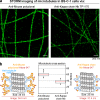A toolbox of anti-mouse and anti-rabbit IgG secondary nanobodies
- PMID: 29263082
- PMCID: PMC5839796
- DOI: 10.1083/jcb.201709115
A toolbox of anti-mouse and anti-rabbit IgG secondary nanobodies
Abstract
Polyclonal anti-immunoglobulin G (anti-IgG) secondary antibodies are essential tools for many molecular biology techniques and diagnostic tests. Their animal-based production is, however, a major ethical problem. Here, we introduce a sustainable alternative, namely nanobodies against all mouse IgG subclasses and rabbit IgG. They can be produced at large scale in Escherichia coli and could thus make secondary antibody production in animals obsolete. Their recombinant nature allows fusion with affinity tags or reporter enzymes as well as efficient maleimide chemistry for fluorophore coupling. We demonstrate their superior performance in Western blotting, in both peroxidase- and fluorophore-linked form. Their site-specific labeling with multiple fluorophores creates bright imaging reagents for confocal and superresolution microscopy with much smaller label displacement than traditional secondary antibodies. They also enable simpler and faster immunostaining protocols, and allow multitarget localization with primary IgGs from the same species and of the same class.
© 2018 Pleiner et al.
Figures






Comment in
-
Open-source recombinant monoclonal secondary nanobodies.J Cell Biol. 2018 Mar 5;217(3):809-811. doi: 10.1083/jcb.201802025. Epub 2018 Feb 14. J Cell Biol. 2018. PMID: 29444803 Free PMC article.
References
Publication types
MeSH terms
Substances
LinkOut - more resources
Full Text Sources
Other Literature Sources
Molecular Biology Databases
Research Materials

